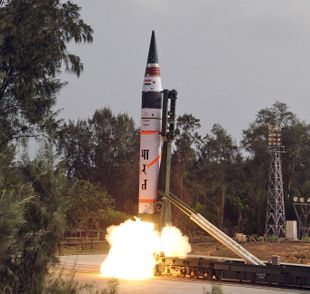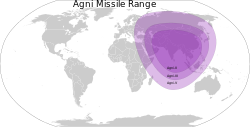أگني-5
| أگني-5 Agni-V | |
|---|---|
 | |
| النوع | صاروخ باليستي عابر للقارات[1][2] |
| مكان الصنع | الهند |
| تاريخ الخدمة | |
| في الخدمة | 2014[3] (Testing) |
| اسُتخدم من قبل | قيادة القوات الإستراتيجية |
| تاريخ الانتاج | |
| المُصنع | منظمة تطوير وأبحاث الدفاع (DRDO)، بهارات دايناميكس (BDL) |
| المواصفات | |
| الوزن | 50,000 كگ[4] |
| الطول | 17.5 متر[5] |
| القطر | 2 متر |
| رأس حربي | نووي |
|
وزن الرأس الحربي |
1500 كگ[9] |
| المحرك | Three stage solid fuel |
| المدى العملي | أكثر من 8000 كگ[1][6] |
| السرعة | 24 ماخ[7] |
| نظام التوجيه |
Ring Laser Gyro- INS (Inertial Navigation System), optionally augmented by GPS, terminal guidance with possible radar scene correlation |
| منصة الإطلاق |
8 x 8 Tatra TEL & Rail Mobile Launcher (Canisterised missile package) [8] |
| النقل | بري أو بالسكك الحديدية |
أگني-5 Agni-V، هو صاروخ باليستي عابر للقارات طورته منظمة تطوير وأبحاث الدفاع (DRDO) الهندية. يمكن للصاروخ توسيع نطاق هجمات الهند الصاروخية لأكثر من 5,000 كم away.[1][2][6] نجح أول إطلاق تجريبي للصاروخ في 19 أبريل 2012 من جزيرة ويلر في اوديشا.[10][11] ورأى الخبراء الصينيون أن لدى الصاروخ بالفعل القدرة على الوصول إلى أبعد من 8,000 كم وأن الحكومة الهندية "قللت القدرة الفعلية للصاروخ لتجنب قلق البلدان المجاورة ".[12][13]
مقدمة
تجهيزات الإختبار
أول إطلاق تجريبي
الوصف
الدفع
النقل
MIRVs
أگني-5 إس إل بي إم
ردود الفعل على الإطلاق التجريبي
محلياً
دول أخرى
 الصين – A spokesman for China's Foreign Ministry, Liu Weimin, said, "China and India are large developing nations. We are not competitors but partners. We believe that both sides should cherish the hard-won good state of affairs at present, and work hard to uphold friendly strategic co-operation to promote joint development and make positive contributions towards maintaining peace and stability in the region."[11] The state-owned China Central Television (CCTV) reported that the test was "a historic moment for India, and it shows that India has joined the club of the countries that own ballistic missiles."[11] However, CCTV listed some of the missile's shortcomings and reported that "it does not pose a threat in reality." More negative commentary can be found in Global Times, which reported that India "still lags behind in infrastructure construction, but its society is highly supportive of developing nuclear power and the West chooses to overlook India's disregard of nuclear and missile control treaties" and warned India not to "over-estimate its strength". Subsequently, they also claimed that India would stand "no chance" in an arms race, and that India's only aim was to "catch up" to China's military power.[14] Chinese experts felt that the missile actually has the potential to reach targets 8,000-km away and that the the Indian government had "deliberately downplayed the missile's capability in order to avoid causing concern to other countries".[15]
الصين – A spokesman for China's Foreign Ministry, Liu Weimin, said, "China and India are large developing nations. We are not competitors but partners. We believe that both sides should cherish the hard-won good state of affairs at present, and work hard to uphold friendly strategic co-operation to promote joint development and make positive contributions towards maintaining peace and stability in the region."[11] The state-owned China Central Television (CCTV) reported that the test was "a historic moment for India, and it shows that India has joined the club of the countries that own ballistic missiles."[11] However, CCTV listed some of the missile's shortcomings and reported that "it does not pose a threat in reality." More negative commentary can be found in Global Times, which reported that India "still lags behind in infrastructure construction, but its society is highly supportive of developing nuclear power and the West chooses to overlook India's disregard of nuclear and missile control treaties" and warned India not to "over-estimate its strength". Subsequently, they also claimed that India would stand "no chance" in an arms race, and that India's only aim was to "catch up" to China's military power.[14] Chinese experts felt that the missile actually has the potential to reach targets 8,000-km away and that the the Indian government had "deliberately downplayed the missile's capability in order to avoid causing concern to other countries".[15]
 پاكستان – Pakistani websites and news agencies prominently displayed news of the launch.[16] An article by the Associated Press reported that Pakistani officials showed no concern, with the foreign office spokesman Mozzam Ahmed Khan saying only that India had informed it of the test ahead of time in line with an agreement they have."[17]
پاكستان – Pakistani websites and news agencies prominently displayed news of the launch.[16] An article by the Associated Press reported that Pakistani officials showed no concern, with the foreign office spokesman Mozzam Ahmed Khan saying only that India had informed it of the test ahead of time in line with an agreement they have."[17]
 المملكة المتحدة – The BBC reported that the launch marked the moment India joined an "elite nuclear club" that also included China, Russia, France, the US, the UK and possibly Israel.[11]
المملكة المتحدة – The BBC reported that the launch marked the moment India joined an "elite nuclear club" that also included China, Russia, France, the US, the UK and possibly Israel.[11]
 الولايات المتحدة – The United States stated that India boasted of an excellent non-proliferation record and that it had engaged with the international community on such issues.[18] Mark C. Toner, a US State Department spokesman said, "We urge all nuclear-capable states to exercise restraint regarding nuclear capabilities. That said, India has a solid nonproliferation record."[19] Moreover, responding to comparisons with North Korea's attempted launch of a long-range rocket that same week, Jay Carney said that, "India's record stands in stark contrast to that of North Korea, which has been subject to numerous sanctions, as you know, by the United Nations Security Council."[17]
الولايات المتحدة – The United States stated that India boasted of an excellent non-proliferation record and that it had engaged with the international community on such issues.[18] Mark C. Toner, a US State Department spokesman said, "We urge all nuclear-capable states to exercise restraint regarding nuclear capabilities. That said, India has a solid nonproliferation record."[19] Moreover, responding to comparisons with North Korea's attempted launch of a long-range rocket that same week, Jay Carney said that, "India's record stands in stark contrast to that of North Korea, which has been subject to numerous sanctions, as you know, by the United Nations Security Council."[17]
منظمات دولية
 ناتو – أعلن أندرس فوگ راسموسن، الأمين العام للناتو أنهم لا يعتقدون أن الهند تشكل تهديد نووي، لا للناتو ولا لحلفائه، على الرغم من تقدم التكنولوجيا النووية في الهند.[20]
ناتو – أعلن أندرس فوگ راسموسن، الأمين العام للناتو أنهم لا يعتقدون أن الهند تشكل تهديد نووي، لا للناتو ولا لحلفائه، على الرغم من تقدم التكنولوجيا النووية في الهند.[20]
مرئيات
<embed width="320" height="240" quality="high" bgcolor="#000000" name="main" id="main" >http://media.marefa.org/modules/vPlayer/vPlayer.swf?f=http://media.marefa.org/modules/vPlayer/vPlayercfg.php?fid=de50f74a3f0ca981ed7" allowscriptaccess="always" allowfullscreen="false" type="application/x-shockwave-flash"/</embed>
انظر أيضاً
تطورات ذات صلة
قوائم ذات صلة
أشخاص ذوي علاقة
- V. K. Saraswat, Director General of DRDO
- Tessy Thomas, Project Director for Agni-V
المصادر
- ^ أ ب ت Rajat Pandit (17 November 2011). "Eyeing China, India to enter ICBM club in 3 months". The Times of India. Retrieved 19 April 2012.
- ^ أ ب Rahul Datta (8 October 2011). "With Russian help, India to enter ICBM club soon". Dailypioneer. Retrieved 20 April 2012.
- ^ "DRDO Lab Develops Detonator for Nuclear Capable Agni-V Missile As It Gets Ready For Launch". Defencenow. 17 January 2012.
- ^ T.S. Subramanian (23 July 2011). "Preparations apace for Agni V launch". The Hindu. Retrieved 19 April 2012.
- ^ "DRDO plans to test 10 missiles this year". The Times of India. 27 January 2011. Retrieved 19 October 2011.
- ^ أ ب ت "Agni-4/5". Missile Threat. 19 July 2010.
- ^ Raj Chengappa (16 April 2012). "India's most potent missile Agni V all set for launch". The Tribune. Retrieved 19 April 2012.
- ^ Y. Mallikarjun, Agni-V design completed; to be test-fired in 2010, The Hindu, 27 November 2008
- ^ Rajat Pandit (20 April 2012). "Canister storage gives N-capable Agni-V missile flexibility". The Times of India. Retrieved 20 April 2012.
- ^ Rajat Pandit (19 April 2012). "Agni-V, India's first ICBM test-fired successfully – The Times of India". The Times of India. Retrieved 19 April 2012.
- ^ أ ب ت ث "India test launches Agni-V long-range missile". BBC. First Post. April 19, 2012. Retrieved April 19, 2012.
- ^ IANS (20 April 2012). "Agni-V can reach targets 8,000 km away: Chinese researcher". The Times of India. Beijing. Retrieved 20 April 2012.
- ^ "India downplaying Agni-V's potential: Chinese expert". First Post. Retrieved 20 April 2012.
- ^ "China critical of Agni-V launch, says India being swept by missile delusion". Indo-Asian News Service. First Post. April 19, 2012. Retrieved April 19, 2012.
- ^ IANS (20 April 2012). "Agni-V can reach targets 8,000 km away: Chinese researcher". The Times of India. Beijing. Retrieved 20 April 2012.
- ^ "Agni-V launch news floods Pak websites". Indo-Asian News Network. First Post. April 19, 2012. Retrieved April 19, 2012.
- ^ أ ب Ravi Nessman (19 April 2012). "India missile test has few critics, unlike NKorea". Associated Press. Retrieved 19 April 2012.
- ^ "India has a solid non-proliferation record: US". Indo-Asian News Network. First Post. April 19, 2012. Retrieved April 19, 2012.
- ^ Heather Timmons and Jim Yardley (19 April 2012). "India, Eye on China, Tests Missile With Longer Range". The New York Times. Retrieved 19 April 2012.
- ^ "India poses no missile threat: NATO". Indo-Asian News Network. First Post. April 19, 2012. Retrieved April 19, 2012.
وصلات خارجية
الكلمات الدالة:
This article contains content from Wikimedia licensed under CC BY-SA 4.0. Please comply with the license terms.
